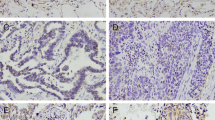Abstract
LRRC3B has emerged as a tumor suppressor in several human cancers. However, its expression pattern and biological roles in human non-small-cell lung cancer (NSCLC) have not been explored. In the present study, we investigated clinical significance of LRRC3B in 101 NSCLC specimens. We found that LRRC3B expression was downregulated in NSCLC tissues compared with normal bronchial epithelium and that its downregulation significantly correlated with tumor–node–metastasis (TNM) stage (p < 0.0001), nodal metastasis (p < 0.0001), and poor patient prognosis (p = 0.0016, log-rank test). We also checked LRRC3B levels in several lung cancer cell lines and found that its expression was downregulated in four of nine lung cancer cell lines compared with normal human bronchial epithelial (NHBE) cell line. We further explored the biological role of LRRC3B. LRRC3B plasmid transfection in H460 and A549 cell lines inhibited proliferation, colony formation ability, and invading ability. Furthermore, we identified that LRRC3B could inhibit cell cycle progression with downregulation of cyclin D1 and decreased MMP9 expression. In addition, LRRC3B depletion in HBE cells promoted proliferation and invasion. In conclusion, our data suggested that LRRC3B may serve as an important tumor suppressor in NSCLC.




Similar content being viewed by others
References
Jemal A, Siegel R, Ward E, Murray T, Xu J, Thun MJ. Cancer statistics, 2007. CA Cancer J Clin. 2007;57(1):43–66.
Minna JD, Roth JA, Gazdar AF. Focus on lung cancer. Cancer Cell. 2002;1(1):49–52.
Schiller JH, Harrington D, Belani CP, Langer C, Sandler A, Krook J, et al. Comparison of four chemotherapy regimens for advanced non-small-cell lung cancer. N Engl J Med. 2002;346(2):92–8.
Dong QZ, Wang Y, Dong XJ, Li ZX, Tang ZP, Cui QZ, et al. CIP2A is overexpressed in non-small cell lung cancer and correlates with poor prognosis. Ann Surg Oncol.
Dong QZ, Zhao Y, Liu Y, Wang Y, Zhang PX, Jiang GY, et al. Overexpression of SCC-S2 correlates with lymph node metastasis and poor prognosis in patients with non-small-cell lung cancer. Cancer Sci. 101(6):1562–9.
Fidler IJ, Kripke ML. Genomic analysis of primary tumors does not address the prevalence of metastatic cells in the population. Nat Genet. 2003;34(1):23. author reply 25.
van’t Veer LJ, Dai H, van de Vijver MJ, He YD, Hart AA, Mao M, et al. Gene expression profiling predicts clinical outcome of breast cancer. Nature. 2002;415(6871):530–6.
Kobe B, Deisenhofer J. A structural basis of the interactions between leucine-rich repeats and protein ligands. Nature. 1995;374(6518):183–6.
Kajava AV, Kobe B. Assessment of the ability to model proteins with leucine-rich repeats in light of the latest structural information. Protein Sci. 2002;11(5):1082–90.
Kobe B, Kajava AV. The leucine-rich repeat as a protein recognition motif. Curr Opin Struct Biol. 2001;11(6):725–32.
Kajava AV. Structural diversity of leucine-rich repeat proteins. J Mol Biol. 1998;277(3):519–27.
Bianchini M, Levy E, Zucchini C, Pinski V, Macagno C, De Sanctis P, et al. Comparative study of gene expression by cDNA microarray in human colorectal cancer tissues and normal mucosa. Int J Oncol. 2006;29(1):83–94.
Kim M, Kim JH, Jang HR, Kim HM, Lee CW, Noh SM, et al. LRRC3B, encoding a leucine-rich repeat-containing protein, is a putative tumor suppressor gene in gastric cancer. Cancer Res. 2008;68(17):7147–55.
Tian XQ, Zhang Y, Sun D, Zhao S, Xiong H, Fang J. Epigenetic silencing of LRRC3B in colorectal cancer. Scand J Gastroenterol. 2009;44(1):79–84.
Kondratov AG, Stoliar LA, Kvasha SM, Gordiyuk VV, Zgonnyk YM, Gerashchenko AV, et al. Methylation pattern of the putative tumor-suppressor gene LRRC3B promoter in clear cell renal cell carcinomas. Mol Med Rep. 2012;5(2):509–12.
Haraldson K, Kashuba VI, Dmitriev AA, Senchenko VN, Kudryavtseva AV, Pavlova TV, et al. LRRC3B gene is frequently epigenetically inactivated in several epithelial malignancies and inhibits cell growth and replication. Biochimie. 2012;94(5):1151–7.
Liu J, Liao Q, Zhang Y, Sun S, Zhong C, Liu X. Cyclin D1 G870A polymorphism and lung cancer risk: a meta-analysis. Tumour Biol. 33(5):1467–76.
Liu Y, Wang L, Lin XY, Wang J, Yu JH, Miao Y, et al. The transcription factor DEC1 (BHLHE40/STRA13/SHARP-2) is negatively associated with TNM stage in non-small-cell lung cancer and inhibits the proliferation through cyclin D1 in A549 and BE1 cells. Tumour Biol. 34(3):1641–50.
Dong QZ, Wang Y, Tang ZP, Fu L, Li QC, Wang ED, et al. Derlin-1 is overexpressed in non-small cell lung cancer and promotes cancer cell invasion via EGFR-ERK-mediated up-regulation of MMP-2 and MMP-9. Am J Pathol. 2013;182(3):954–64.
Jian H, Zhao Y, Liu B, Lu S. SEMA4b inhibits MMP9 to prevent metastasis of non-small cell lung cancer. Tumour Biol. 2014;35(11):11051–6.
Song H, Tian Z, Qin Y, Yao G, Fu S, Geng J. Astrocyte elevated gene-1 activates MMP9 to increase invasiveness of colorectal cancer. Tumour Biol. 2014;35(7):6679–85.
Feng X, Miao G, Han Y, Xu Y. CARMA3 is overexpressed in human glioma and promotes cell invasion through MMP9 regulation in A172 cell line. Tumour Biol. 2014;35(1):149–54.
Acknowledgments
The study was supported by Outstanding Scientific Fund of Shengjing Hospital (No. 201205).
Conflicts of interest
None
Author information
Authors and Affiliations
Corresponding author
Electronic supplementary material
Below is the link to the electronic supplementary material.
Supplementary Figure 1
LRRC3B depletion promotes growth, invasion, cyclin D1 and MMP9. A. Western blot analysis showed that siRNA markedly decreases its levels in HBE cells compared with control. B. MTT assay showed that LRRC3B depletion increased cell growth rate. C. Colony formation assay showed that LRRC3B depletion increased colony number. D. Matrigel invasion assay showed that LRRC3B depletion facilitated HBE cell invasion. E. Western blot analysis showed that LRRC3B depletion slightly upregulated cyclin D1 and MMP9. (GIF 62 kb)
Rights and permissions
About this article
Cite this article
Kan, L., Li, H., Zhang, Y. et al. LRRC3B is downregulated in non-small-cell lung cancer and inhibits cancer cell proliferation and invasion. Tumor Biol. 37, 1113–1120 (2016). https://doi.org/10.1007/s13277-015-3833-0
Received:
Accepted:
Published:
Issue Date:
DOI: https://doi.org/10.1007/s13277-015-3833-0




